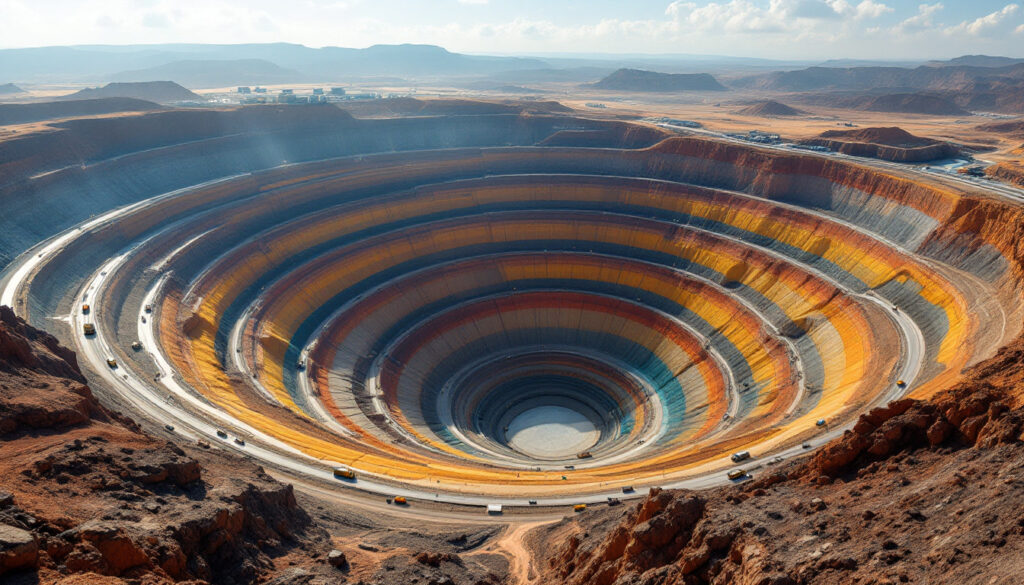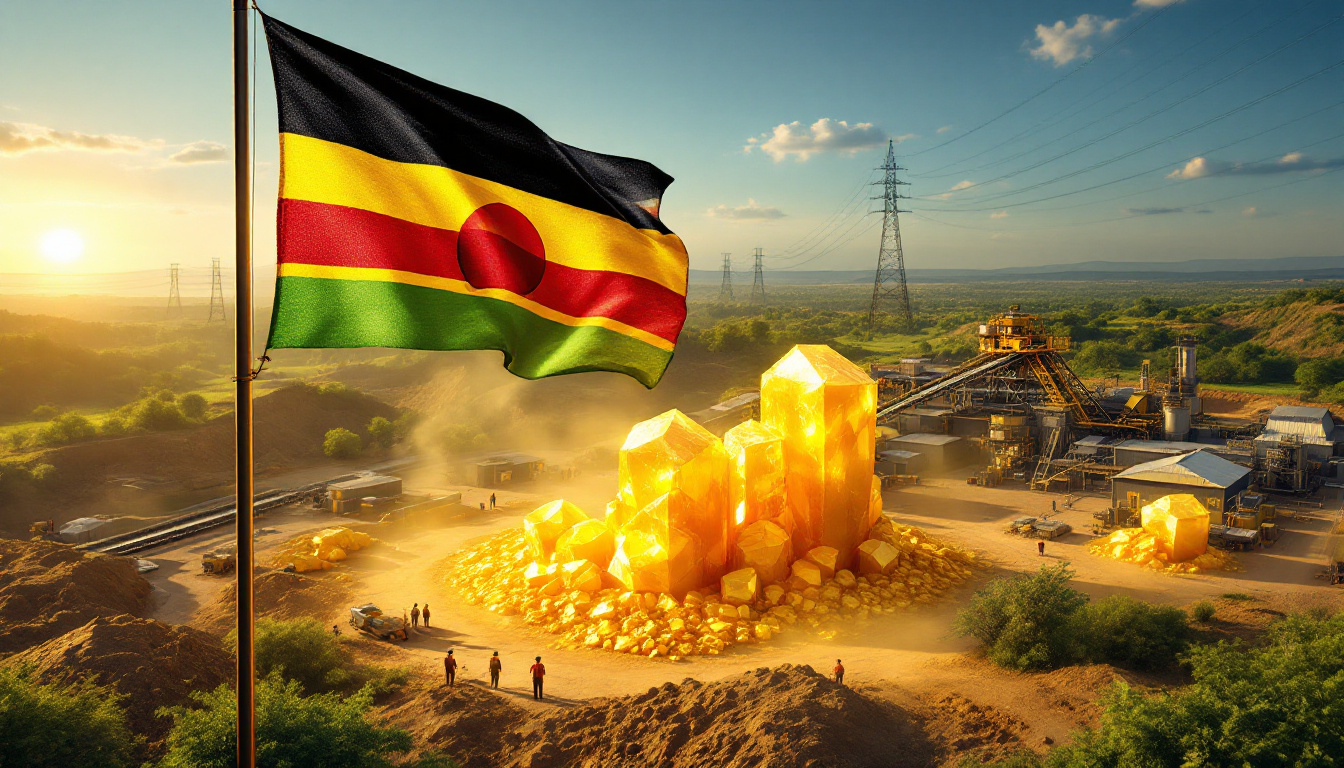What Are the Largest Open Pit Mines in the World?
Open pit mines represent some of the most awe-inspiring engineering achievements on our planet. These massive excavations, often visible from space, demonstrate humanity's ability to reshape the Earth's surface in pursuit of valuable resources. The largest open pit mines in the world serve as testament to both technological innovation and environmental challenges, providing essential materials that power the global economy while leaving significant footprints on the landscape.
The scale of these operations is difficult to comprehend – pits measuring kilometers across and plunging deeper than the height of the world's tallest buildings. Let's explore these colossal excavations and their impact on global mineral production, technological advancement, and environmental stewardship.
How Do Open Pit Mines Impact Global Resource Production?
Open pit mining represents a critical method for extracting valuable minerals on a massive scale. These excavations are so enormous they can often be seen from space, serving as visible reminders of humanity's resource demands.
The world's largest open pits contribute significantly to global supplies of copper, gold, diamonds, and other essential resources. According to the USGS Mineral Commodities Report, open-pit mining accounts for approximately 60% of global copper production and 85% of iron ore extraction. The top 10 open-pit mines alone produce 18% of the world's gold, highlighting their outsized importance in resource markets.
"Modern geospatial technologies allow us to optimize extraction rates while minimizing environmental footprint," explains Dr. Elena Marquez, Mining Engineer at Rio Tinto. These technological advancements have enabled mines to reach unprecedented depths while maintaining operational efficiency.
Engineering innovations have enabled mines to reach depths exceeding 1,200 meters while maintaining operational efficiency. The average mine depth has increased 45% since 2000, with modern pits now reaching up to 1.6 kilometers deep. This remarkable depth is made possible through GPS-controlled haul trucks with payloads exceeding 400 tons and advanced blasting techniques using algorithmic charge patterns to maximize ore recovery.
Perhaps most impressive is the industry's continuous evolution. What began as relatively simple excavations have transformed into highly sophisticated operations employing digital twins transforming mining efficiency, real-time geological modeling, and increasingly, renewable energy sources to power these massive undertakings.
What Makes Bingham Canyon Mine the World's Largest Man-Made Excavation?
Located in the Oquirrh Mountains of Utah, southwest of Salt Lake City, Bingham Canyon Mine stands as the most impressive open-pit operation in terms of overall excavation volume. The mine spans approximately 4 kilometers across and plunges over 1.2 kilometers deep, creating a pit so massive it can be easily identified from the International Space Station.
In operation since 1906, Bingham Canyon has extracted over 19 million tons of copper throughout its storied history. More impressive still, the mine has cumulatively moved an astounding 15 billion tons of material since operations began, processing approximately 150,000 tons of ore daily using advanced autonomous drilling systems.
Owned by the Rio Tinto Group and managed by Kennecott Utah Copper LLC, Bingham Canyon produces significant quantities of gold, silver, and molybdenum as valuable by-products alongside its primary copper production. The operation has survived major challenges, most notably the 2013 massive landslide that shifted millions of cubic meters of rock and temporarily disrupted operations.
The landslide event, while devastating, demonstrated the mine's resilience and technological preparedness. Advanced monitoring systems had predicted the failure, allowing the site to be evacuated before the slide occurred. The recovery effort showcased state-of-the-art slope stability monitoring technologies now standard across major mining operations.
Bingham Canyon has pioneered technological advances in excavation, waste management, and ore processing throughout its century-plus existence. Today, the operation employs real-time slope stability monitoring systems and is pioneering efforts in automation and sustainable mining practices that are setting standards for the global industry.
How Has Chile Dominated Global Copper Production with Its Giant Mines?
Chile has established itself as the undisputed copper titan, producing approximately 28% of the world's copper supply through its network of massive open-pit operations. Two mines in particular stand out for their extraordinary scale and productivity.
Chuquicamata Mine (Chile)
The Chuquicamata Mine ranks as the second-deepest open pit mine in the world, having been operated since 1915 by state-owned Codelco. This historic mine has recently transitioned to combined surface and underground operations to extend its productive lifespan.
Located on the 14-kilometer-long Chuqui Porphyry Complex, the mine represents one of the most significant copper deposits ever discovered. The underground expansion began in 2019, extending the mine's productive life while demonstrating the evolution of mining techniques from purely open pit to hybrid operations.
Chuquicamata has pioneered innovative water conservation techniques, achieving remarkable 75% water reuse rates through advanced recycling systems – a critical achievement in the arid Atacama region where water resources are scarce.
Escondida Mine (Chile)
Escondida stands as the world's largest single copper producer, co-owned by BHP (57.5%), Rio Tinto (30%), and JECO (12.5%). The mine produced 824.4 kt in the first half of 2022, 12% higher than 2021, and reached approximately 1.1 million metric tons of copper production in 2024 according to the latest Cochilco Report.
Located in the Atacama Desert at 3,050 meters above sea level, Escondida's reserves included 2,018 mt of copper sulphide ore grading 1.24% total Cu. The operation has undergone multiple expansions, increasing capacity from 320,000 tpa to over 800,000 tpa.
What truly sets Escondida apart is its commitment to sustainability through decarbonisation in mining. The mine operates one of the largest solar power installations dedicated to mining operations, significantly reducing its carbon footprint while maintaining production levels.
Both Chilean giants employ solvent extraction-electrowinning (SX-EW) technology to process copper ore more efficiently, allowing for the extraction of copper from lower-grade deposits that would previously have been uneconomical.
Why Are Russia's Diamond Mines Among the World's Most Impressive Excavations?
Russia's diamond industry, centered in the remote eastern regions of Siberia, features some of the most impressive and challenging mining operations on the planet due to extreme conditions and remarkable geological formations.
Mirny Diamond Mine (Russia)
Located in eastern Siberia in the Sakha Republic, the Mirny Diamond Mine measures 1,200 meters in diameter and 525 meters deep, creating a massive funnel-shaped void in the permafrost landscape. Operations began in 1957 after the discovery by Yuri Khabardin in 1955, setting off a diamond boom in Soviet Russia.
Miners at Mirny faced extreme challenges with temperatures as low as -40°C, requiring specialized steel alloys for equipment and innovative techniques to work through the permafrost layer. Despite these challenges, production was so substantial it affected global diamond market prices, forcing foreign competitors to adjust pricing strategies.
The airspace above the mine remains closed to helicopters due to accidents attributed to downward air currents created by the pit's unique shape and temperature differentials – an unusual hazard not found at other mines.
Mirny closed open-pit operations in 2001 after decades of production, but the legacy of this remarkable excavation continues to influence diamond mining practices worldwide.
Udachnaya Pipe (Russia)
The Udachnaya Pipe stands as one of the oldest and most productive diamond mines in Russia. Operated by ALROSA, the world's largest diamond mining company, the mine yielded approximately 10.4 million carats in its final operational year according to ALROSA's 2024 reports.
Open-pit mining began in 1971, reaching peak production in the early 1990s. The pit extends more than 630 meters deep, making it one of the 10 deepest open-pit mines globally.
The discovery followed the first Yakut diamond find in 1949, with early prospecting yielding 43 crystals with high grades of about 3 carats per cubic meter. Geological surveys of the Siberian craton kimberlite formations revealed unique mineralogical compositions that contribute to the exceptional quality of Russian diamonds.
ALROSA's economic influence through these operations has provided Russia significant control over global diamond supply chains between 1990-2020, enabling strategic market positioning alongside the De Beers Group.
What Makes Indonesia's Grasberg Mine Unique Among Global Mining Operations?
Located in the Papua-Indonesian highlands, the Grasberg Mine presents a study in extreme mining amid challenging geographical conditions. As one of the largest producers of gold and copper globally, Grasberg operates at elevations exceeding 4,000 meters above sea level in some of the most remote terrain on Earth.
Grasberg is operated by Freeport-McMoRan with a majority stake held by the Indonesian government following nationalization efforts in recent years. The operation spans several kilometers with depths exceeding 600 meters, creating a massive terraced excavation visible from satellite imagery.
What truly distinguishes Grasberg is its ability to overcome extreme logistical challenges of its remote jungle and mountainous location. Materials, equipment, and personnel must navigate treacherous mountain roads that frequently wash out during intense rainfall events. The mine employs thousands of workers, contributing significantly to regional economic development despite political tensions in Papua province.
The deposit contains a copper-gold porphyry deposit requiring advanced extraction technologies, including an elaborate conveyor system that transports ore through the mountainous terrain to processing facilities. Recent years have seen Grasberg transitioning toward underground operations as the open pit reaches economic limits – a pattern repeated across many global mega-mines.
Grasberg's environmental challenges remain significant, with tailings management in the steep mountain terrain representing one of mining's most complex waste disposal scenarios. The operation continues to balance production demands with ESG challenges and opportunities in mining within Indonesia's developing regulatory framework.
How Do Australia and North America Compete in the Global Mining Landscape?
While South America and Russia host some of the world's largest mines, Australia and North America maintain significant competitive positions through technological innovation, efficient operations, and high-grade deposits in specific minerals.
Fimiston Open Pit (Australia)
Known as the Super Pit, Australia's largest open pit gold mine measures 3.5 kilometers in length, 1.5 kilometers in width, and 600 meters deep. Now fully owned by Northern Star Resources after a merger with Saracen Mineral, the operation represents Australia's flagship gold producer.
The mine is currently undergoing an A$1.5 billion expansion to increase production to 900,000 ounces annually by 2029. This massive capital investment demonstrates continued confidence in large-scale open pit mining despite global trends toward underground operations.
Fimiston has emerged as a leader in mining technology adoption, piloting hydrogen fuel cell haulage vehicles as part of Australia's push toward lower-emission extraction methods. These environmental initiatives complement the mine's economic significance to Western Australia's goldfields region.
Diavik Diamond Mine (Canada)
Located on an island in Lac de Gras, 300 kilometers northeast of Yellowknife, Diavik represents North America's premier diamond mining operation. Operating since 2003 with approximately 1,330 on-site employees, the mine has recovered over 144 million carats of diamonds to date.
Diavik's remote subarctic location presents unique operational challenges, requiring specialized ice road logistics during winter months and complete self-sufficiency during summer isolation. The operation demonstrates innovative approaches to mining in a hostile subarctic climate, including wind farm integration that reduces diesel consumption by approximately 10%.
The mine is expected to cease operations by 2026, showcasing the finite nature of even the largest mineral deposits and the importance of comprehensive closure planning. Diavik's reclamation plans represent some of the most advanced environmental restoration commitments in the industry.
Betze-Post Mine (United States)
Part of the Goldstrike mining complex in Nevada, Betze-Post stretches nearly 3.5 kilometers long and over 500 meters deep. The operation produced 642,493 ounces of gold and 87,223 ounces of silver in 2015, demonstrating America's continued significance in precious metals production.
Combined with underground operations, Betze-Post accounted for 24% of Nevada's gold production, ranking as the eighth largest gold mine in the world in 2018 with 795,663 ounces produced. The operation contributes significantly to Nevada's economy, employing hundreds of workers with some of the highest mining wages globally.
The Nevada complex exemplifies modern digital integration in mining operations, utilizing artificial intelligence for real-time ore sorting and predictive maintenance systems that achieve 90% accuracy rates in production forecasting trials.
What Is the Future of Open Pit Mining in Peru?
Peru continues to emerge as a major mining jurisdiction, with significant open pit operations contributing to its position as a top global producer of copper, silver, zinc, and gold. Among these operations, Cerro Verde stands out as a world-class copper producer.
Cerro Verde Mine (Peru)
Located in southwestern Arequipa, Cerro Verde contributes approximately 17% of Peru's total copper output and 30% of molybdenum. The mine ranks among the top five biggest copper producers globally with 454 kt produced in 2023.
Ownership is split between Freeport-McMoRan (53.56%), Sumitomo Metal Mining (21%), and other stakeholders including local interests. The operation was recently approved for a $600 million expansion project that will extend its productive capacity significantly.
Cerro Verde currently processes more than 400,000 tonnes of ore per day through one of the world's largest concentrator facilities. The operation is projected to maintain production until 2052, representing one of the longest mine lifespans among current major operations.
What makes Cerro Verde particularly noteworthy is its innovative approach to water management in an arid region. The operation constructed a wastewater treatment facility that provides both mining water requirements and improved sanitation for nearby communities – a model of industry-community partnership.
Peru's mining sector continues to navigate complex social and political environments, with Cerro Verde often cited as an example of successful community engagement strategies that balance industrial development with local concerns.
What Environmental and Sustainability Challenges Do Open-Pit Mines Face?
The environmental footprint of open-pit mining represents one of the industry's greatest challenges and areas of focused innovation. These massive operations face several significant environmental hurdles.
Landscape disruption and habitat destruction from overburden removal can permanently alter ecosystems. Modern mines now allocate between 15-20% of operational budgets to rehabilitation efforts according to the International Council on Mining & Metals (ICMM) 2025 Sustainability Report.
Water usage concerns for ore processing can strain local supplies, particularly in arid regions where many major mines operate. Leading operations now achieve 75-85% water recycling rates through closed-loop systems that minimize freshwater consumption.
Air pollution and greenhouse gas emissions from heavy machinery remain significant, though average energy consumption has been reduced 33% through the deployment of hybrid excavators according to recent Caterpillar white papers. The industry demonstrates increasing commitment to emissions reduction, with 78% of new projects incorporating carbon capture systems or renewable energy integration.
Bingham Canyon's biodiversity restoration program has replanted over 3,000 acres of disturbed land, establishing a framework for post-mining landscape recovery that other operations increasingly emulate. This demonstrates the industry's focus on efficient water management and energy use.
The industry is experiencing a significant shift toward balancing productivity with environmental responsibility. The United Nations Environment Programme has established 2030 zero-waste mining targets that are reshaping operational planning across the sector.
Innovative approaches to minimize ecological impact while maximizing extraction increasingly involve mining's role in the clean energy transition, allowing preventative rather than reactive environmental management.
FAQ: Common Questions About Open-Pit Mining
What are open-pit mines, and why are they significant?
Open-pit mines are large excavations dug into the ground to extract valuable minerals and metals located close to the surface. Unlike underground mining, they involve removing large quantities of soil and rock to access ore deposits. Their significance stems from their scale, volume of production, economic impact, and engineering achievements, providing essential materials for global industries.
What environmental and sustainability challenges do open-pit mines face?
Open-pit mines face challenges including landscape disruption, habitat destruction, water usage concerns, and pollution from operations. Modern mines are addressing these issues by integrating sustainable practices such as renewable energy sources, efficient water management, and responsible closure planning to balance productivity with environmental stewardship.
How Do These Massive Mining Operations Shape Our Future?
The largest open pit mines in the world demonstrate human determination in harnessing Earth's resources at unprecedented scales. These engineering marvels continue to evolve through technological innovations that extend mine lifespans and improve operational efficiency.
Strategic expansions at mines like Fimiston and Cerro Verde ensure long-term viability of resource supplies critical to modern life. The industry's AI-powered ore sorting systems now achieve 90% accuracy rates in trials, revolutionizing how valuable minerals are separated from waste rock.
Mining remains crucial for supplying raw materials that power economies and daily life. The electrification of transport and renewable energy infrastructure depends heavily on copper, lithium, and rare earth elements
Ready to Capitalize on the Next Major Mineral Discovery?
Track significant mineral discoveries as they happen with Discovery Alert's proprietary Discovery IQ model, which instantly analyses ASX announcements for high-potential opportunities. Explore how historic discoveries have generated substantial returns by visiting the dedicated discoveries page and begin your 30-day free trial today to gain that crucial market advantage.




